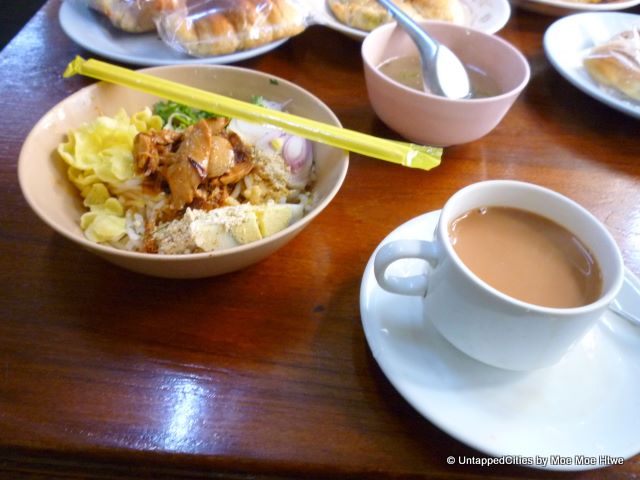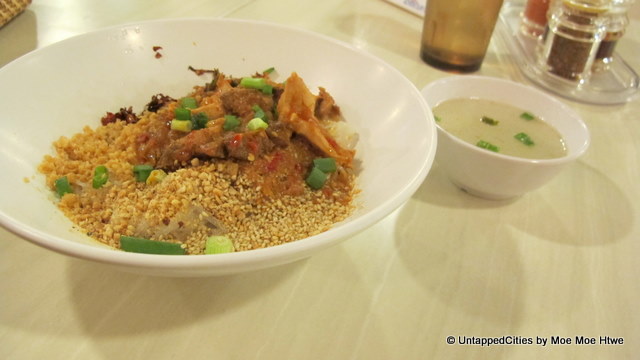Everyone who has been to Singapore knows it as “little Asia,” a diverse island-city but few know that there is an enclave of Burmese population in Singapore, which is estimated in the tens of thousands in Singapore. The meeting point for most is right smack in the middle of the city at Peninsula Plaza, in the City Hall area, and a place where Burmese flock to for their authentic cuisine.
How do I begin to describe Burmese food? Everyone assumes it must taste like Thai food, seeing how the nations are neighbours. However, to me, Burmese food, although has similarities to the food of all of its neighbours (India, Thailand, China), has very distinct qualities that are its very own.
When you get to Peninsula Plaza, go to any of the first six floors (Basement to level five) and you will have an array of cafes, restaurants and food courts selling Burmese food. Dispersed between employment agencies, clothing stores, camera shops and more, you will be spoilt for choice of Burmese food.
What you usually see in these restaurants and cafes are that there is a myriad of meat, fish and vegetables dishes to choose from, usually displayed for all to see. However, for this post, I’m going to describe a variety of Burmese noodle dishes to try.
One of the reasons is that apart from the one restaurant (Shwe Inle) in the basement of Peninsula, which has an extensive menu with English descriptions, many other smaller cafes in Peninsula Plaza usually have “made to order” noodles, so a visitor not familiar with Burmese food might easily miss it.
To start off, head to “Mya Nandar” at the basement of Peninsula Plaza and you can try “Nan Gyi Thote” , a chicken curry and noodle salad. “Nan Gyi” refers to the type of noodles, big-flat ones in this case and “Thote” means salad. The chicken used is the most basic Burmese chicken curry. It also contains chickpea flour, sliced onions, chilies (you can choose your spice levels although most Burmese like it hot), slices of hard-boiled egg, and garnished with crispy noodle pieces and usually zested with lime or lemon. Simple yet delicious, you will find this in most Burmese food establishments.
Another popular Burmese noodles is called “Shan Kaut Swear” . “Shan” is the name of the state this popular noodles hail from in the eastern part of Burma, and “kaut swear” means noodles. You can have it in soup or as a salad. I, however, like it as a salad as it is more flavorful to me. It has relatively simple ingredients – rice noodle, chicken or pork cooked in a dry curry way, tomatoes, ground peanuts, sour mustard greens, chilli and some starch. It doesn’t sound amazing when I list the ingredients out but taste it and you will discover that the myriad of ingredients make it savoury and a must-try dish.
Another dish that I’d recommend would be the most famous noodle dish in Burma. For this, head to “Win Myanmar” on the fourth floor of the Peninsula Plaza. This dish would be “Mon Hin Gha” . Although this is a dish often eaten for breakfast in Burma, you can order this dish all day long in Peninsula Plaza. This is a dish with rice noodles (notice the trend here? Rice noodles are used in most noodle dishes) in a bowl of piping hot fish soup/chowder.
Most popular fish used is catfish and it contains spices and a very interesting ingredient–slices of banana heart/stem–makes it crunchy. It is garnished with slices of boiled egg and fried chick peas and you can put in fish sauce, lime and chili flakes as you wish. You can also put in fried gourd if you prefer crunchy bits in your bowl of noodles.
Don’t be surprised if you order a second bowl of “Mon Hin Gha”. I’ve not known anyone to just have one. I can’t find a picture of a bowl of “Mon Hin Gha” but here is a link to a picture of it.
Other noodle dishes that you can find in Peninsula Plaza are “See Chat Kaut Swear,” a simple salad of yellow egg noodles with minced chicken, “Rakhine Mon Tee Thote,” a salad of rice noodles with minced fish–careful though–this is only for those looking for a fiery noodle salad.
Rakhine:
Another thing about Burmese food, that you will notice, is that different restaurants often make it differently so don’t be surprised if recipes are different as they are often tweaked by different families and passed down through generations. Only extremely popular dishes such as “Mon Hin Gha” will have a standard taste. The rest will vary slightly depending on the cook making it. To me, this is what makes Burmese fair unique.
Go on then, tap into Peninsula Plaza in Singapore to get your fill of Burmese food.








